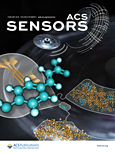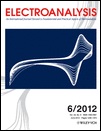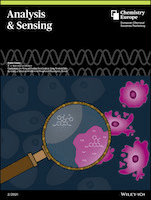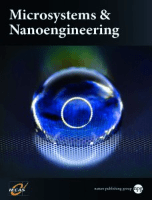
ACS Sensors
metrics 2024
Enhancing accessibility to cutting-edge sensor discoveries.
Introduction
ACS Sensors, published by the American Chemical Society, is a premier journal focusing on the rapidly evolving field of sensors and sensing technologies. With an ISSN of 2379-3694, it has established itself as a key resource for researchers and professionals in bioengineering, fluid flow, instrumentation, and process chemistry. The journal holds a remarkable Q1 ranking across multiple categories, indicating its influential position within the academic community, with Scopus rankings placing it in the top echelons of its fields. Since its inception in 2016, ACS Sensors has provided high-quality, peer-reviewed research that drives innovation and application in sensor technology. The journal encourages submissions of original research articles, reviews, and technical notes that advance the understanding of sensing systems, showcasing novel methodologies and applications. While currently operating under a subscription model, the journal is committed to enhancing accessibility to cutting-edge discoveries. By fostering a collaborative environment for scientists and engineers, ACS Sensors is vital in bridging the gap between theory and practical applications, making it an essential read for those engaged in sensor development and application across various disciplines.
Metrics 2024
 1.70
1.70 8.20
8.20 8.40
8.40 107
107Metrics History
Rank 2024
Scopus
IF (Web Of Science)
JCI (Web Of Science)
Quartile History
Similar Journals

ChemNanoMat
Navigating the Frontiers of Chemistry and NanotechChemNanoMat is a prestigious academic journal published by WILEY-V C H VERLAG GMBH, dedicated to the rapidly evolving fields of nanoscale materials and their applications in diverse areas such as biomaterials, energy engineering, and environmental sustainability. With the journal's ISSN 2199-692X and recognized quality, as evidenced by its Q2 rankings across multiple categories—including Biomaterials and Renewable Energy—ChemNanoMat serves as a crucial platform for researchers, professionals, and students to disseminate their findings and foster collaborations. Operating from Germany, the journal encourages the exploration of innovative materials solutions to meet tomorrow's challenges. While it does not currently offer open access options, it remains highly regarded in the academic community with a competitive impact factor that emphasizes its relevance and influence in guiding future research directions. Covering a broad scope from 2015 through 2024, ChemNanoMat is key for anyone invested in the advancement of materials chemistry and related scientific fields.

Journal of Sensors and Sensor Systems
Connecting Researchers in Sensor ScienceThe Journal of Sensors and Sensor Systems, published by COPERNICUS GESELLSCHAFT MBH, is a prominent open-access journal that has been contributing to the fields of electrical and electronic engineering and instrumentation since its inception in 2012. With an ISSN of 2194-8771 and an E-ISSN of 2194-878X, this journal provides a critical platform for researchers, professionals, and students to disseminate innovative findings and advancements in sensor technology and system applications. As of 2023, it holds a respectable ranking in the third quartile for Electrical and Electronic Engineering and in the fourth quartile for Instrumentation, as per Scopus classifications. The journal is based in Göttingen, Germany, and emphasizes the importance of open access for broad dissemination of knowledge. By fostering interdisciplinary research and collaboration, The Journal of Sensors and Sensor Systems plays an essential role in advancing sensor technologies, ultimately driving progress in various scientific and engineering domains.

ELECTROANALYSIS
Empowering Researchers with High-Impact Electroanalytical FindingsELECTROANALYSIS is a premier journal published by WILEY-V C H VERLAG GMBH that serves the dynamic field of analytical and electrochemistry. Established in 1989, this scholarly publication has successfully converged its focus to cover a wide array of topics including novel electrochemical methods, sensor technology, and environmental analysis, reflecting the latest advancements and trends in the field. With an impressive 2023 impact factor that places it in the Q2 quartile of Analytical Chemistry and Q3 quartile in Electrochemistry, the journal is recognized for its high-quality research and contributions. Its Scopus rankings further reinforce its credibility, standing at #46/156 in Analytical Chemistry and #26/60 in Electrochemistry. Although currently not offering Open Access, the journal remains a significant resource for researchers, professionals, and students keen to stay at the forefront of electroanalytical techniques. With a global readership, ELECTROANALYSIS continues to drive knowledge and innovation within the scientific community.

Photonic Sensors
Transforming Ideas into Applications in Photonic SensorsPhotonic Sensors is a premier open access journal published by Springer, focusing on the rapidly evolving fields of Photonics, Materials Science, and Optics. Since its inception in 2011, this journal has become a vital platform for disseminating cutting-edge research and innovative applications in photonic technologies, addressing a range of topics from optical sensors to advanced materials for photonics. With an impressive impact factor and categorized in the Q2 quartile across both Atomic and Molecular Physics and Electronic, Optical and Magnetic Materials, it ranks among the top publications in its field (47th out of 284 and 38th out of 224, respectively, in Scopus). The journal actively encourages contributions that not only advance theoretical understanding but also pave the way for practical solutions in various industries. Photonic Sensors is essential reading for researchers, professionals, and students keen on exploring the frontiers of photonic research, with open access ensuring wide visibility and engagement within the scientific community.

Sensors and Actuators Reports
Advancing the Frontiers of Sensor and Actuator TechnologySensors and Actuators Reports, published by Elsevier, is a premier open access journal that has been contributing to the fields of physics, computer science, and engineering since its establishment in 2019. With its ISSN 2666-0539, this journal has rapidly gained recognition, achieving Q1 quartile rankings across multiple categories, including Atomic and Molecular Physics, Computer Science, and Electrical Engineering. By providing a platform for high-quality research and innovative findings, Sensors and Actuators Reports is dedicated to advancing knowledge in sensor and actuator technologies, which are pivotal for numerous applications in modern science and industry. The journal's performance is underscored by its impressive Scopus rankings, placing it in the top tiers across various disciplines. Open access ensures that research is widely disseminated, fostering collaboration and enabling researchers, professionals, and students alike to engage with the latest advancements in their fields.

InfoMat
Fostering Collaboration in the World of Materials ScienceInfoMat is a premier open-access journal published by WILEY that serves as a vital resource for scholars and practitioners in the fields of materials science, materials chemistry, and related disciplines. Since its inception in 2019, this journal has rapidly ascended in academic stature, currently holding a prestigious Q1 ranking across multiple categories, including Electronic, Optical and Magnetic Materials, Materials Chemistry, and Surfaces, Coatings and Films, showcasing its significant impact and relevance. With a commendable impact factor and a comprehensive scope, InfoMat provides a platform for high-quality research that drives innovation in the materials domain, appealing to researchers, professionals, and students alike. The journal’s open-access model enhances visibility and accessibility of cutting-edge studies, fostering a collaborative and informed scientific community. Based in the United Kingdom, InfoMat continues to shape the future of materials research through its commitment to excellence and accessibility.

Microfluidics and Nanofluidics
Connecting Researchers in the World of Micro and NanofluidicsMicrofluidics and Nanofluidics is a distinguished academic journal published by Springer Heidelberg, focusing on the rapidly evolving fields of micro and nanotechnology. With a commitment to disseminating cutting-edge research, this peer-reviewed journal aims to bridge the gap between fundamental science and practical application within Condensed Matter Physics, Materials Chemistry, and Nanoscience and Nanotechnology. It holds an influential position in its field, reflected by its Category Quartiles (Q3) and notable Scopus Rankings, including a ranking of #145 in Condensed Matter Physics. Researchers, professionals, and students will find this journal to be an invaluable resource for accessing pioneering studies, methodologies, and innovative technologies essential for advancing knowledge and applications in micro and nanofluidics. With an extensive history from 2004 to 2024, Microfluidics and Nanofluidics continues to foster discussion and collaboration within the scientific community, solidifying its role as a leading platform for scholarly communication in this dynamic discipline.

Analysis & Sensing
Illuminating the Path of Scientific DiscoveryAnalysis & Sensing is a prominent academic journal published by WILEY-V C H VERLAG GMBH, focusing on the critical fields of Analytical Chemistry, Electrochemistry, Spectroscopy, and Biochemistry. Established within the converged years from 2021 to 2024, the journal aims to advance knowledge in analytical and sensing techniques, providing a platform for high-quality research that reflects current trends and challenges in the scientific community. With a Scopus ranking that highlights its credibility—ranking 101st in Analytical Chemistry and 43rd in Electrochemistry—the journal caters to researchers, professionals, and students striving to enhance their understanding of analytical processes and methodologies. Although not open access, the quality of the articles published ensures a rigorous peer-review system, making it a vital resource for those who wish to remain at the forefront of research innovation in analytical sciences. Additionally, its global reach, indicated by its effective dissemination and relevance, underscores the journal's significance within the realm of chemical research.

Microsystems & Nanoengineering
Catalyzing Collaboration in the World of MicrosystemsMicrosystems & Nanoengineering, published by SpringerNature, stands at the forefront of advancing knowledge in the fields of atomic and molecular physics, condensed matter physics, electrical and electronic engineering, and materials science. With an impressive impact factor and categorized in Q1 across multiple prestigious fields in 2023, this journal not only provides a platform for high-quality research but also reflects the vitality of innovations within these disciplines. Since its transition to Open Access in 2015, it has significantly broadened accessibility for researchers, professionals, and students globally, facilitating the dissemination of groundbreaking findings. Addressed in the United Kingdom, with a focus on interdisciplinary collaboration, Microsystems & Nanoengineering aims to foster connections between theoretical advancements and practical applications, serving as a crucial resource for those engaged in cutting-edge nanoscale technologies and microsystems development. Immerse yourself in the latest studies and engage with the vibrant community that shapes the future of science and engineering.

MICROCHEMICAL JOURNAL
Exploring the Depths of Microchemical TechniquesMicrochemical Journal, published by Elsevier, stands as a leading scholarly publication in the fields of Analytical Chemistry and Spectroscopy, boasting impressive rankings of Q1 and Q2 in their respective categories for 2023. With an H-index reflecting its substantial impact and relevance, this journal has been a cornerstone of research dissemination since its inception in 1957, and it continues to play a vital role in advancing the methodological and technological innovations within these disciplines. The journal presents peer-reviewed articles that explore a wide array of topics, making it an essential resource for researchers, professionals, and students keen on the latest advancements in microchemical processes and techniques. Although it does not currently offer open access options, its publication through Elsevier ensures a high standard of academic integrity and wide accessibility through various academic institutions. With a strong Scopus ranking—9th in Chemistry Spectroscopy and 22nd in Analytical Chemistry—Microchemical Journal is an indispensable platform for empirical studies, insightful reviews, and pioneering methodologies in the microchemical domain.